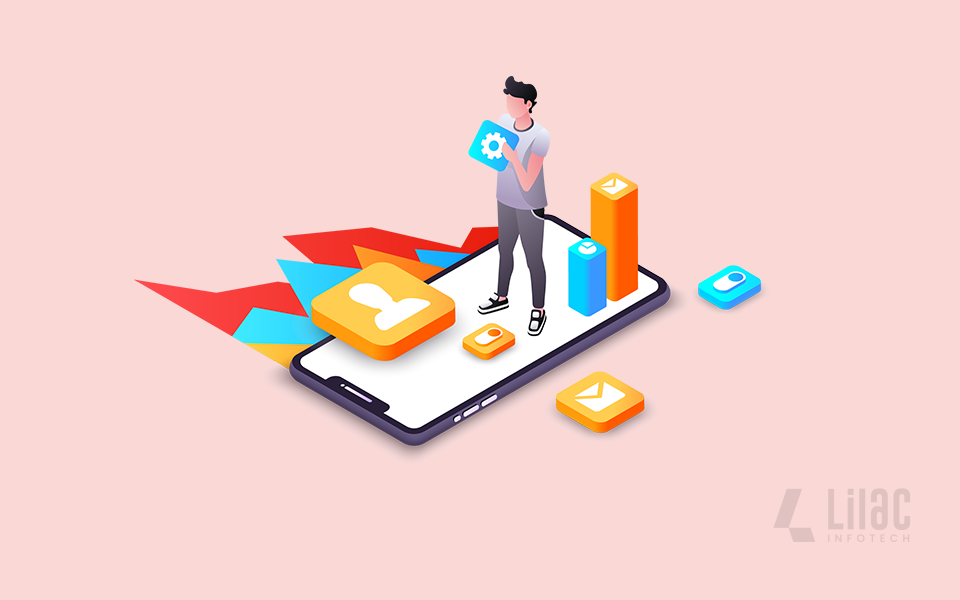
Apps are no longer just for the techie or geekier businesses. In fact, whether you have a large internet presence or not, having an app for your business is more important than ever.
Apps enable your consumers to communicate with you or make purchases while on the move and provide extra features and functionalities for your business's operations, marketing initiatives, client retention, and more.
This is especially true as mobile apps become increasingly prevalent across all industries. The majority of smartphone users spend most of their time on their smartphones using applications of some form or another. If you want your business to thrive, you need an app. However, designing an effective app will be difficult if you don't know what you're doing. Let's break down the application development cycle so you know what to anticipate, what to budget for, and how to go about producing a beautiful app for your business without making mistakes.
What Are the Stages of the Application Development Cycle?
App development is a continuous process of concept generation, prototyping, development, and deployment. However, the stages of app development – from the first idea or iteration to a complete launch on supported app marketplaces – may be generally divided into five primary categories.
Discovery, Market Research, and Planning
The first stage of app development is divided into three sub stages: discovery, market research, and planning. The most natural of them is discovery - imagine coming into a need or problem that you need to tackle with an app. You identify a problem that can be remedied by building or improving an app, and then you devise a strategy to carry out that notion.
Discovery Phase
You may also start the discovery process if you already have a few outstanding mobile app ideas for your business stashed away. Regardless, the creation of every app begins with a single fundamental notion of necessity. However, a concept alone is insufficient to create great software, especially for your firm. Following that, you'll need to conduct some market research - your app concept may be extraordinary, and you need to discover if there is a market for it or if such an app can benefit company operations. Don't forget that security is essential at every level; taking care of your start-up’s safety will serve as the cornerstone of your firm.
If not, the app may not be worth the time or money it takes to build.
To do appropriate market research, you should ask questions such as:
- What is the intended audience?
- What does the absolution serve?
- What languages will the app support?
- What are your competitors doing?
- What is the entire budget for the app's development: the timeline?
- How will you sell or promote this app?
Planning Phase
If you can answer all of those questions satisfactorily (for example, you discover a market for your app concept and a feasible budget in your company account), you may start planning.
This entails coming up with answers to some of the difficult problems raised above. Create a budget, and a timetable, and decide who will work on the app. Is it going to be you or a team from your company's IT department? If it's a freelancer, you'll need to set up communication strategies as well.
You'll also want to identify the app's main features or functionalities to avoid overdevelopment.
Discuss About Your Idea?
Get Your Own App for Your Business?
Wireframing and Design
You may now go to the next stage of the app development cycle. To begin with, design, consider the answers to the previous main questions, such as who the app will be for and what services it will give. You may use the responses to create a broad design for the app. For example, if your app is intended to serve as a mobile store for your company, you'll need e-commerce capability as well as a variety of payment options for your clients. You will also need to get to "wireframing."
Wireframing is app development jargon for creating a clear image of your ideas and demonstrating how the app's many features or functionalities will combine to provide a working interface. Consider this storyboarding or road planning for the next application's development. To wireframe, you or others in your development team can create a sketch of the app and how it will look on paper or in software.
Remember that you want to:
- Prioritize the user experience over all other considerations.
- Place your brand anywhere it is suitable.
- Remember that you're creating a mobile app rather than a website, which necessitates distinct solutions or tactics.
Backend of the app
You'll need to work out the backend of your app as you wireframe. This is everything that you and your team will interact with daily to operate the app and solve client complaints. Choose the backend architecture that will support your app in terms of servers, data integration, push notification services, and other features.
Wireframing is important throughout this stage of the app development process because you may alter the frame if you run into constraints or budget concerns.
However, you will eventually need to complete your wireframe and create a prototype. A prototype is the initial working iteration of an app's concept. It's not something you'll show to your clients or users, but it should be mostly functional and provide you and your team with a foundation for future growth. Create your app's prototype using the wireframe you created before. Then, after the app is mostly working, have it tested by a few individuals outside your development team.
During the complete development application cycle, they may give essential and meaningful feedback on the app, how it feels, and any pain spots that need to be addressed.
Development Phase
Once your prototype is complete, you should have a laundry list of things to develop or alter regarding the app's fundamental design. This is the development stage of the app creation process. Creating an app entails several complicated procedures. You will need to:
- Create storage solutions and databases.
- Configure servers for your app's backend.
- Create developer accounts for app shops for easier distribution.
- Program and code the software yourself or hire developers based on your skillset.
- Create the "skins" or screens for your app, which should resemble the storyboard designs from your wireframing work.
All of these processes will take weeks or months to complete. Furthermore, as you develop, you'll want to make sure you don't go over budget and code so that you hit all of the primary functions and features you planned to include in the app throughout the early stages of the cycle.
If you do employ developers to perform the coding and programming for you, remember to take your time choosing the right person, but don't be afraid to terminate them if things aren't going well. When it comes to hiring outside labour, a freelancer, the rule is "hire slow, dismiss fast."
Quality Assurance
Testing, often known as quality assurance, is the next phase in the application development cycle. Even if your app looks fantastic when development is nearly complete, you can't be positive that it will perform as stated or provide a pleasant experience for your consumers unless you test it.
You should conduct extensive testing on your own - pull out your wireframe drawings and early concepts and go over the various features you've incorporated. If something was included, try it out and assess how it compares to your initial expectations for the function.
Furthermore, you should engage outside users to test the app or have workers test the app as part of their job obligations.
You should additionally test for the following:
How the images hold up over time, and how they influence modern mobile device hardware is not known. If multiple photos have enough cross-platform compatibility (if applicable), If the update/bug-fixing system is responsive, can you put out updates or critical bug patches as soon as they are detected?
Spend plenty of time on software testing to optimize your app's success and reduce the shame you'd experience if you released something sloppy. However, after testing is over, you may proceed to the last and most pleasurable stage of the app development process.

Deployment: The Application Development Cycle's Final Stage
Deployment is the fifth and final stage of the application development cycle. However, if you want to ensure success, you must plan ahead of time.
For example, you must ensure that your marketing team or department is involved in them to develop an effective marketing campaign or advertising plan. This is the only way for your software to be instantly purchased or downloaded after it has been uploaded to multiple stores.
- Marketing
Marketing should do keyword research to optimize both the app's name and its accompanying SEO language, such as app descriptions, adverts, and so on. App store optimization, or ASO, is a different but connected focus to SEO: the former is critical so that your app doesn't get buried behind the hundreds of others that are likely to arrive in the same month.
Remember to support and advertise your app on your website, if you have one. If not, it may be prudent to create a landing page for that program so that people can locate it and be directed to a download page. Include information about the debut of your app in your social media and email marketing as well.
- Official Launch:
Make sure to publicize the formal launch of your app everywhere you can, and consider hiring copywriters or bloggers to promote the app through their reviews or announcement pieces.
Building momentum is essential for a successful launch. It's also critical to pay attention to early feedback from your app's first users. If they uncover a defect in the app, you may have enough time to mobilize your bug-fixing staff and resolve the issue before the bulk of your users do.
In any case, make sure you have a very obvious path for any feedback and that you reply to your customers' initial remarks.
- Updates
Even once your app is out, you'll need to have some people on hand to answer consumer complaints and carry out infrequent repairs and upgrades. Updates are major modifications to your app's code or programming that should be made after gathering a considerable amount of similar user input.
After gathering feedback, you can essentially repeat the app development cycle: devise a solution to problems people are encountering with your app, wireframe that solution, test it using a prototype version of the live app, then build in the fix and deploy it to live users.
As you can see, the application development cycle is never truly complete. This, however, guarantees that your software is as effective and functional as possible!
Conclusion
Finally, even if you aren't IT-savvy, the app development cycle is simple to grasp once you see it in its entirety. All business owners and developers may use this basic template to speed up the app development process and guarantee that development deadlines are met. If you follow these five stages when developing your app, you will have a lot more enjoyable experience. Good luck!



















Post a Comment